Art & Exhibitions
David Ebony’s Top 10 New York Gallery Shows for October
Reviews of Ragnar Kjartansson, Cory Arcangel, Michelle Grabner, and more.
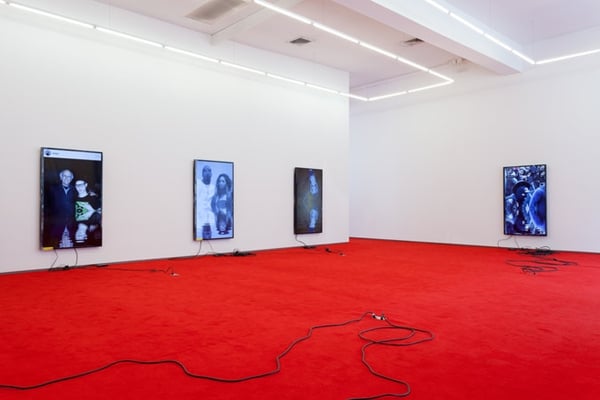
Photo: Courtesy Team Gallery.
Reviews of Ragnar Kjartansson, Cory Arcangel, Michelle Grabner, and more.

David Ebony


Ragnar Kjartansson and the National at Luhring Augustine, Bushwick.
Photo: Courtesy Luhring Augustine.
1. Ragnar Kjartansson and the National, at Luhring Augustine Bushwick, through December 21.
A description of A Lot of Sorrow, a new six-hour video by Icelandic artist Ragnar Kjartansson, might sound formidable, if not foreboding. Kjartansson is renowned for his live, endurance-based performances centered on repeated music compositions, but this one would seem to be especially demanding as a video. It’s a single channel film of a rock band, the National, performing a slow lament, Sorrow, live on stage at New York’s PS1 in 2013. The band performs the three-minute pop song over and over again nonstop for the entire six hours. Patient viewers are in for a surprise, though. Rather than a frightful bore, the work has a hypnotic quality that takes effect after a surprisingly short time. Slight variations in the song—subtle instrumental and vocal nuances each time it is performed—pull you in. Offering a riveting and ultimately emotional experience, the forlorn tone eventually becomes a meditative tonic that allows you to examine the joys and sorrows of your own existence.
Projected on a large screen in the darkened gallery, the film conveys the feeling of being in the front row at the concert. Excellent camerawork, in the manner of a rock documentary, and terrific sound heighten the illusion. Kjartansson himself appears only peripherally in the film, like a roadie. On the far side of the stage, he pours drinks for the band and crew, and at one point bounds onto the stage with a tray of sandwiches, adding a touch of humor to the proceedings. In this work, Kjartansson manages to transform a rather modest song into something truly Wagnerian. A Lot of Sorrow has the gorgeous and crowd-pleasing quality of a pop hit as well as the challenging and thought-provoking attributes of a great work of art.

Installation of Cory Archangel’s “tl;dr” at Team Gallery
Photo: Courtesy Team Gallery.
2. Cory Arcangel at Team, through October 26.
Visitors literally get the red carpet treatment in “tl;dr,” an exhibition of recent “video-photos” by New York artist Cory Arcangel. The gallery’s red-carpeted floor clues viewers in to the fact that they are in the presence of celebrities, or least representations of them on large video monitors hung vertically. There’s P. Diddy descending the staircase of a private jet in one work; elsewhere, a blurry video portrait of Jay-Z and Beyoncé; Hillary Clinton promoting her latest book; and Britney Spears striking a pose, are among the familiar personalities who make appearances on the “red carpet.” These computerized images are part of a series called “Lakes,” in which Arcangel employs an old Java applet, “lake.” The program creates undulating rivulets in one part of the screen, usually the lower portion, while the remainder of the picture remains static.
The novel technique results in some uncanny effects, as if the celebrities were standing in water, their figures reflected in the shimmering pools. The works spark all sorts of metaphors. Have the polar ice caps already melted, filling the world’s culture capitals with water? Or do these works constitute a comment on the inherent narcissism of celebrity and its attendant consumer culture? One of the best pieces suggests an otherworldly landscape, with a blue orb looming high above a glowing red ocean. What planet is this, anyway?

James Siena, Non-Slice, 2005
Photo: Photograph by Ellen Labenski, Copyright James Siena, Courtesy Pace Gallery
3. “Spaced Out: Migration to the Interior” at Red Bull Studios, through December 14.
Plush wall-to-wall carpeting must be all the rage these days for cutting-edge exhibition display. A fluffy cotton-candy pink rug covers the lower level of “Spaced Out: Migrations to the Interior,” an engaging group show occupying two floors of this kunsthalle-like space. In his third venture as a curator, artist and Brooklyn Rail founder Phong Bui, in collaboration with Rail Curatorial Projects, has gone all out. He enlisted Jim Lambie to cover the first floor with a 3,000-square-foot installation made of colorful vinyl tape. Along with Day-Glo colored walls, these outlandish floor coverings help convey a dreamlike environment, in which Bui installed an array of sculptures, paintings and installations intended to elicit a hallucinogenic experience and some uncommon reveries.
Psychedelic abstract paintings by artists such as Fred Tomaselli, Bruce Pearson, Alexander Ross, James Siena, and Philip Taaffe, play against quasi-surrealist figurative paintings and sculptures by Peter Saul, Lisa Yuskavage, Rona Pondick, Ugo Rondinone, and Charles LeDray, among others. The show is an over-the-top hodgepodge of works by artists with wildly divergent agendas. But there are fine examples here by some classic contemporaries, and somehow the components make a cohesive whole. It’s well worth the trip.
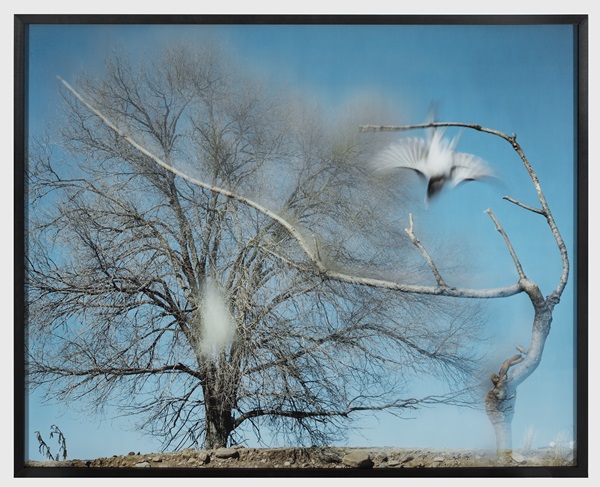
Jean-Luc Mylayne, #560, Janvier, Février (2008).
Photo: Courtesy Gladstone.
4. Jean-Luc Mylayne at Gladstone Gallery, through November 8.
Jean-Luc Mylayne’s sumptuous, large-scale photographs of landscapes with birds at first seem implausible and artificial. The small birds lining pools of water or roosting on tree branches appear content and so perfectly poised that they look digitally enhanced or Photoshopped. But the pictures actually result from the French artist’s painstaking process and dedicated interaction with the avian world. He spends weeks watching birds and waiting with his equipment at the ready. Eventually, he achieves a mutual familiarity with his subjects that allows him to take these extraordinary shots.
No. 189, a characteristic—and stunning—work, shows a row of six small birds congregating around a circular pool or birdbath. They seem to communicate with each other in calm discourse in an idealized image of serene nature. A similarly mesmerizing work, depicting a far more agitated scene, No 560 features two white birds, perhaps a predatory species in mid-flight. Photographed against a crystal-blue background, with the blurry wings suggesting furtive action, the birds dive from their perches on leafless trees. Their aim, supposedly toward an unseen prey, remains unsure, but certainly adds an enigmatic element to this unforgettable image.
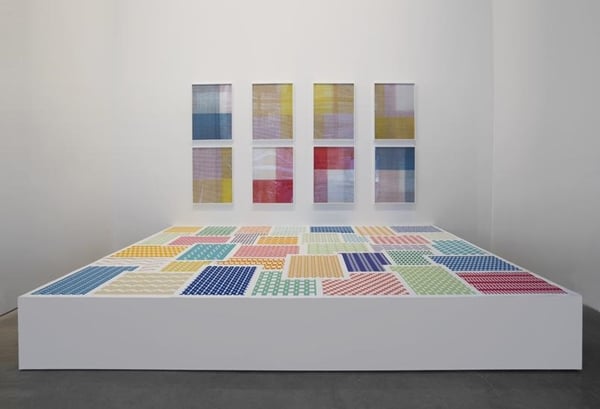
Installation view of Michelle Grabner at James Cohan Gallery.
Photo: Courtesy James Cohan Gallery.
5. Michelle Grabner at James Cohan, through November 8.
Following her successful turn as one of a trio of curators of this year’s Whitney Biennial, Wisconsin-born, Chicago-based artist Michelle Grabner turns in an impressive show of her own recent work. Obsessed with patterns, she uses them in a variety of mundane and high-tech materials in this colorful and audacious group of works. A series of untitled inkjet prints reproduced multicolored geometric compositions made of woven paper. A series of enamel on panel paintings features irregular rows of organic shapes in tones of black, white, and gray.
The centerpiece of the show, Oyster #9, is a massive circular sculpture suspended from the ceiling like a giant mobile. A collaboration with her husband Brad Killam, the disk is made of clusters of flattened galvanized steel garbage can lids. Despite the work’s title the disk more closely suggests a moon rising above a landscape, albeit made of abutting panels of woven colored paper in geometric patterns lying flat on a raised platform. Suspended on a chain nearby, an arrangement of found objects—a child’s chair and table and a framed photograph—appears as a jarring contradiction. Full of unexpected associations and implications, the unlikely addition manages to activate the entire installation.

David Humphrey, Xanax, 2014
Photo: Courtesy Fredericks & Freiser
6. David Humphrey at Fredericks & Freiser, through November 8.
One of David Humphrey’s most cohesive exhibitions, “Work and Play” contains 16 recent paintings and sculptures that feature wildly imaginative approaches to the figure and convey the New York artist’s uniquely acerbic sense of humor. One canvas, On the Couch, is a striking image showing a seated male figure with legs crossed. The lower portion of the figure is well defined, while, contradictorily, the faintly outlined shoulders and face seem to dissolve into the ethereal blue background.
Another large painting, Intended (6 by 5 feet), appears nearly totally abstract, a nod to AbEx painting, perhaps. Against a white background, wispy stokes of red and blue, however, reveal a stylized face and an arm reaching toward the right. Among the strangest works here are the sculptures, such as Modern Artist and Campfire, made of rather unusual materials, such as painted foam, paper pulp, wood, and hydrocal. These raucous pieces imply an exploration of psychological states and relationships to space and time rather than studies of the human figure or animal shapes.
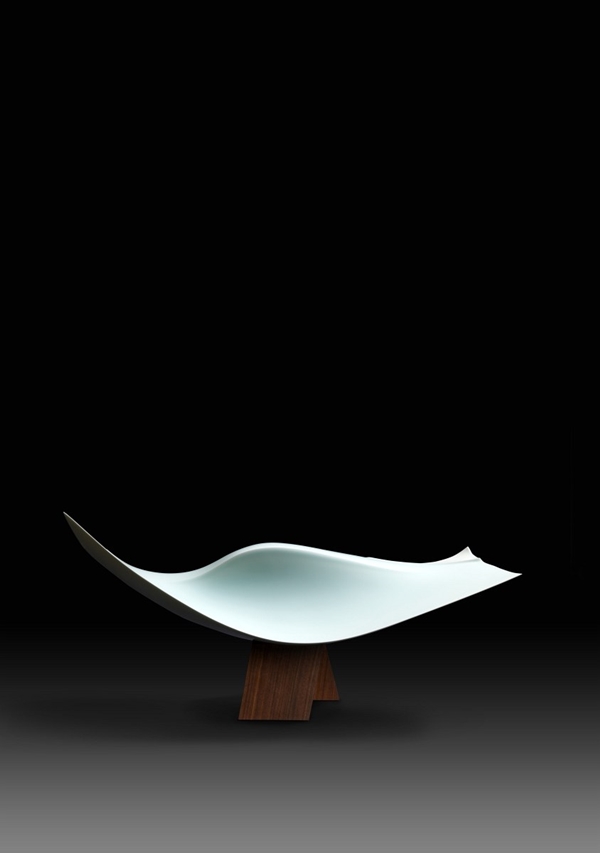
Sueharu Fukami, Bo II (undated).
Photo: Courtesy Erik Thomsen Gallery.
7. Fukami Sueharu at Erik Thomsen, through November 8.
This show, a mini-retrospective of works by the master Japanese ceramicist Fukami Sueharu, is a rare event. It contains a representative selection of the ultra-refined porcelain sculptural objects and vessels that Fukami has produced since the mid 1970s. On view are a number of his soaring vertical pieces made of cast porcelain, such as Spirit “Rising on the Wind,” and the nearly six-foot-tall Landscape II, based on the shape of a Samurai sword. All of the pieces are glazed with similar delicate shades of pale green-blue, which suggest sky or water, most lyrically conveyed in works like Clear and Hope II, whose curving horizontal shapes suggest gently rolling ocean waves.
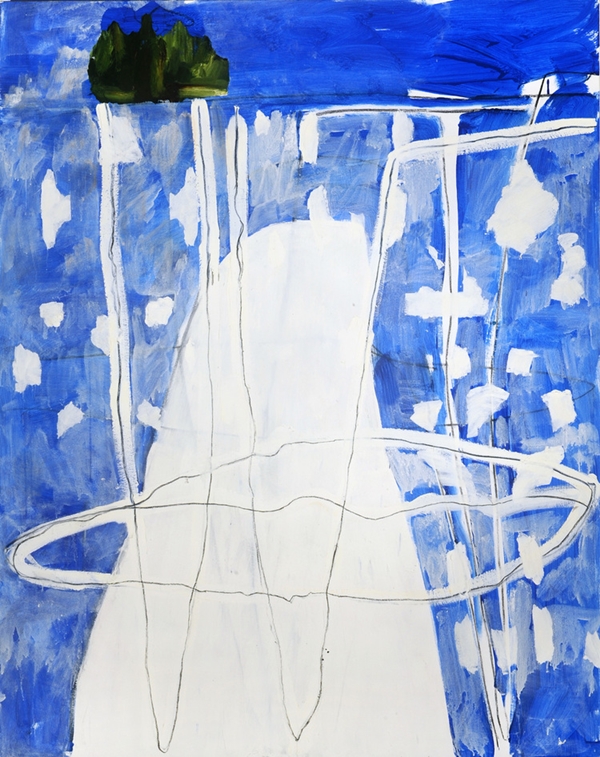
John Walker, Touch (2013).
Photo: Courtesy Alexandre Gallery.
8. John Walker at Alexandre Gallery, through November 15.
Sober but not somber, the recent paintings by veteran painter John Walker in this show represent something of a departure. Like his earlier quasi-abstract canvases, these works by the English-born, Maine-based artist are rich with texture and subtly nuanced color, but those here also closely reference the landscape and seaside areas in the vicinity of his studio in South Bristol, Maine. Among the best works, Brake II features vertical zigzag bands of blue and white impasto. They indicate the motion of waves lapping at two rock formations, loosely triangular in shape and defined by patches of horizontal green and dark blue jagged lines. Above this muscular seascape, at the top of the canvas, a rising full moon seems to illuminate the scene. More playful in tone, a series of small oil studies on bingo cards with vaguely rectangular shapes in white set against green backgrounds hints at a snow-covered peninsula jutting out into a wintry sea.
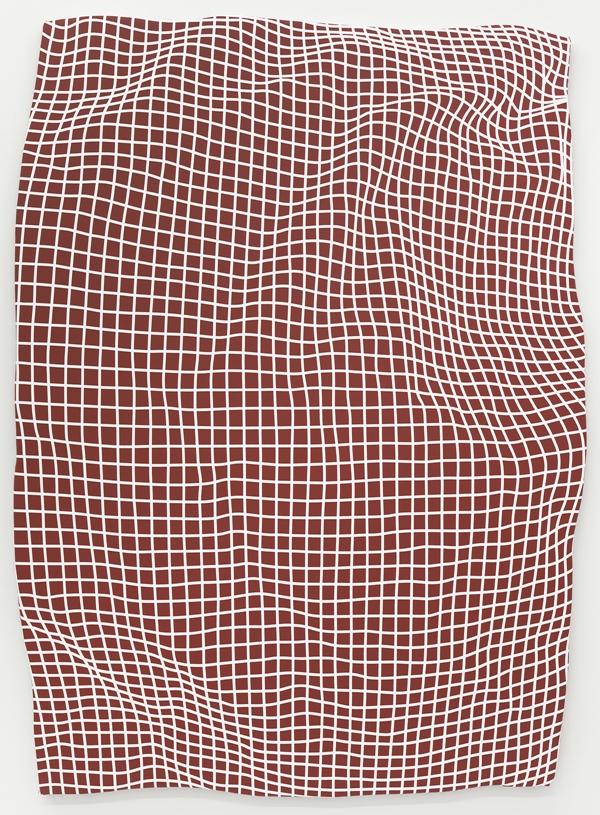
Jeremy DePrez, Untitled (2014). Photo: Courtesy Zach Feuer.
9. Jeremy DePrez at Zach Feuer, through November 8.
Maine-born, Houston-based artist Jeremy DePrez, age 31, makes an impressive New York solo debut with this show titled “Tenant.” In 17 large paintings, DePrez explores a wild array of abstract painting styles with total disregard for the conventional boundaries that post-war art criticism for so long imposed on these various idioms. His irreverence is infectious. Op and Abstract Pop references collide in some of the works, while Color Field and Abstract Expressionism are gainfully reassessed in others. Shaped canvases such as Untitled (MMMMMMMMM) recall Lynda Benglis’s poured pigment floor pieces of the early 1970s, and Envelop (Crusty) recalls an overblown Richard Tuttle work from the 60s. In the exhibition’s press release, DePrez says he based all the works here on a buttoned up dress shirt like the kind his father used to wear. So the personal feeling and psychological dimension I recognized in each of these pieces was not simply imagined.
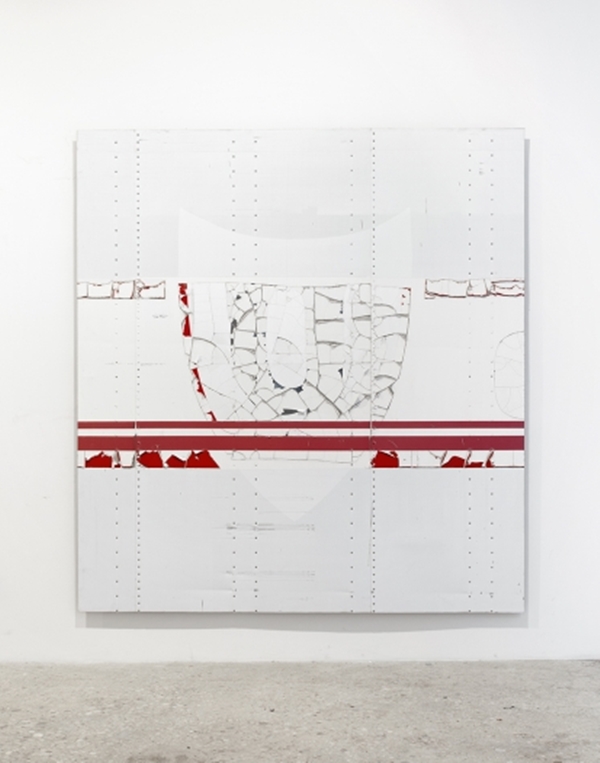
Gedi Sibony, Wyo (2014).
Photo: Courtesy Greene Naftali
10. Gedi Sibony at Greene Naftali, through November 8.
Known for his airy installations using abject materials like Sheetrock, cardboard, and masking tape, New York artist Gedi Sibony presents in this show large wall-hung works that come close to conventional painting. Constructed of aluminum semi-trailer pieces cut in rectangular shape and only intermittently embellished with touches of paint, the works in the show have a resplendent quality and a painterly feel. Outstanding among them is All, featuring the word’s orange lettering almost completely obliterated with paint, and Stumble Riser, with its rough-hewn geometric design looming like the wall of some massive ruin of Industrial Age architecture.